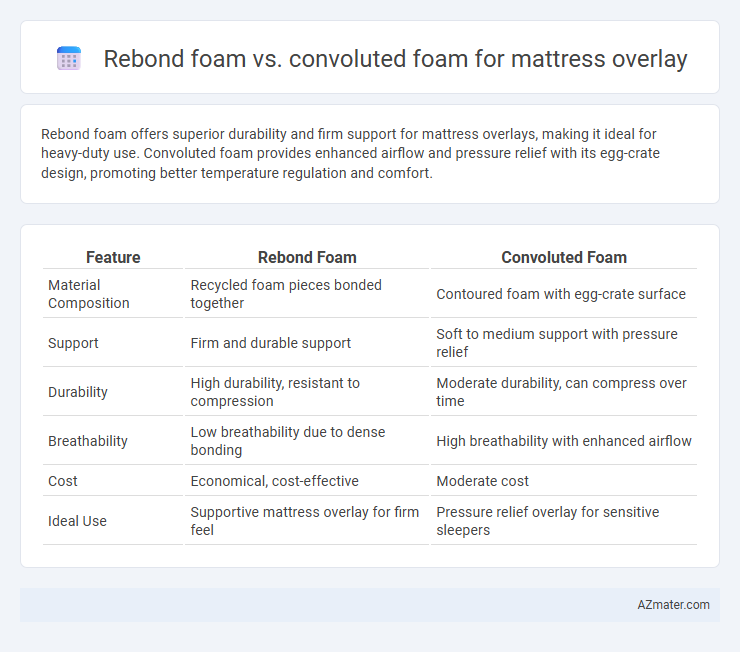Rebond foam offers superior durability and firm support for mattress overlays, making it ideal for heavy-duty use. Convoluted foam provides enhanced airflow and pressure relief with its egg-crate design, promoting better temperature regulation and comfort.
Table of Comparison
| Feature | Rebond Foam | Convoluted Foam |
|---|---|---|
| Material Composition | Recycled foam pieces bonded together | Contoured foam with egg-crate surface |
| Support | Firm and durable support | Soft to medium support with pressure relief |
| Durability | High durability, resistant to compression | Moderate durability, can compress over time |
| Breathability | Low breathability due to dense bonding | High breathability with enhanced airflow |
| Cost | Economical, cost-effective | Moderate cost |
| Ideal Use | Supportive mattress overlay for firm feel | Pressure relief overlay for sensitive sleepers |
Overview of Mattress Overlay Materials
Rebond foam, made from shredded foam scraps bonded together, offers high density and firm support ideal for mattress overlays needing durability and pressure relief. Convoluted foam, characterized by its egg-crate shape, enhances airflow and provides targeted comfort by distributing weight evenly and reducing pressure points. Both materials improve mattress comfort but differ in firmness, breathability, and cushioning benefits, catering to various sleep preferences and support needs.
What is Rebond Foam?
Rebond foam is a type of high-density polyurethane foam created by shredding and compressing scrap foam pieces, resulting in a durable and supportive mattress overlay material. This foam offers excellent pressure distribution and resilience, making it ideal for enhanced comfort and longevity in bedding applications. Rebond foam typically provides firmer support compared to convoluted foam, which features a softer, egg-crate surface designed for airflow and cushioning.
What is Convoluted Foam?
Convoluted foam, also known as egg crate foam, features a distinctive surface with peaks and valleys designed to improve airflow and provide targeted pressure relief. This type of foam is commonly used in mattress overlays to enhance breathability and reduce heat retention compared to solid foam types like rebond foam, which consists of shredded foam pieces bonded together for durability and firmness. Convoluted foam offers a softer, more cushioning feel, making it ideal for those seeking improved comfort and support on top of a firm mattress base.
Key Differences: Rebond Foam vs Convoluted Foam
Rebond foam, made from shredded scrap polyurethane foam fused together, offers higher density and firmer support compared to convoluted foam, which features a distinctive egg-crate pattern designed to enhance airflow and pressure relief. Rebond foam excels in durability and load-bearing capacity, making it ideal for mattress overlays requiring sturdy support, whereas convoluted foam prioritizes breathability and comfort by reducing heat retention and improving body contouring. The key difference lies in rebound foam's denser, more resilient structure versus convoluted foam's softer, air-circulating design tailored for pressure point alleviation.
Comfort and Support Comparison
Rebond foam provides firm and dense support, making it ideal for mattresses that require enhanced durability and pressure relief, while convoluted foam offers superior airflow and a softer, more contouring comfort due to its egg crate design. Rebond foam maintains structural integrity and evenly distributes body weight, reducing pressure points, whereas convoluted foam excels in breathability and provides gentle cushioning with targeted support zones. Choosing between rebond and convoluted foam depends on whether the priority is long-lasting support or maximizing airflow and contouring comfort in a mattress overlay.
Durability and Longevity
Rebond foam offers superior durability and longevity compared to convoluted foam due to its dense composition made from shredded polyurethane foam bonded together, providing enhanced resilience against wear and deformation. Convoluted foam, characterized by its egg-crate design, tends to compress more quickly under continuous pressure, reducing its lifespan and support effectiveness over time. For mattress overlays, rebond foam is a more durable option that maintains structural integrity longer, making it ideal for users seeking long-lasting comfort and support.
Pressure Relief Capabilities
Rebond foam offers firm support with moderate pressure relief by distributing weight evenly across its dense structure, making it suitable for individuals seeking durability and stability in a mattress overlay. Convoluted foam excels in pressure relief by promoting airflow and contouring to body curves with its egg-crate design, effectively reducing pressure points and enhancing comfort. The choice between rebond and convoluted foam depends on balancing desired firmness with targeted pressure pressure alleviation for optimal sleep quality.
Breathability and Temperature Regulation
Rebond foam offers moderate breathability with its dense structure, making it less effective at promoting airflow compared to convoluted foam. Convoluted foam's egg-crate design enhances ventilation, facilitating superior temperature regulation by allowing heat and moisture to dissipate efficiently. For mattress overlays emphasizing breathability and cooling, convoluted foam provides a more effective solution.
Cost and Affordability
Rebond foam offers a cost-effective solution for mattress overlays due to its manufacturing process, which repurposes shredded foam pieces, making it more affordable than convoluted foam. Convoluted foam typically costs more because of its specialized egg-crate design, which enhances airflow and pressure relief but increases production expenses. For budget-conscious consumers seeking basic support and durability, rebond foam provides a lower-priced option without significant compromise on comfort.
Which Foam Overlay is Best for You?
Rebond foam offers dense support and durability, making it ideal for individuals needing firm mattress overlays that maintain shape over time. Convoluted foam delivers superior airflow and pressure relief due to its egg-crate design, benefiting those seeking enhanced breathability and comfort. Choosing between rebond and convoluted foam depends on your preference for firmness versus cushioning and ventilation in mattress overlays.

Infographic: Rebond foam vs Convoluted foam for Mattress overlay
 azmater.com
azmater.com